With today’s digital technology, it has never been easier to search, access product information and make online purchases. Therefore, every business has the opportunity to display its products online.
The online market for beauty products is fiercely competitive, with cosmetics alone representing almost $14 billion in sales in 2023. Breaking into this market is undoubtedly tough. But with the help of SEO, it is possible for any brand, even small startups.
The beauty industry is highly competitive, making it challenging to gain visibility in search. But by improving the SEO of your website, you can significantly boost your visibility and drive a significant volume of organic traffic to your range of beauty products. To achieve organic visibility, you should make sure that product pages are optimised for search engines so that they can be found in the search results.
In this article, we will share strategies for improving your product page in the beauty industry, focusing on SEO content and technical factors.
Why is SEO important for product pages?
Achieving higher rankings on search engines is the most effective strategy for drawing in traffic. Statistics reveal that the top three search results get, on average, over 54% of clicks. Improving your rankings brings organic traffic to your website and significantly elevates your brand’s visibility and sales. Additionally, SEO enhances the user experience and leads to higher revenue.
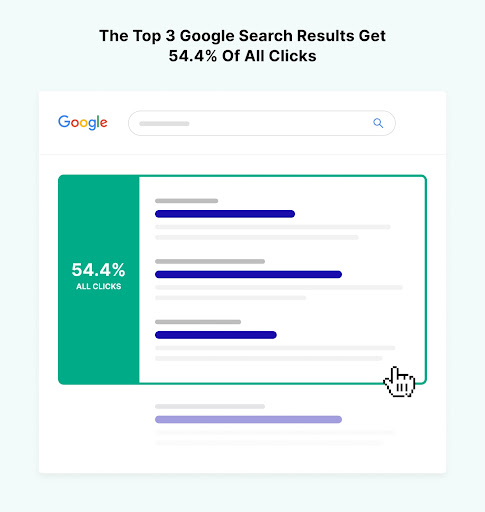
How to optimise product pages for SEO?
There are multiple factors that can help to improve the SEO of your product pages. Here are the elements that will help you optimise product pages effectively.
The key areas of focus in SEO content are:
- Conduct detailed keyword research
- Match keyword research to product names
- Write metadata that catches people’s attention
- Create engaging and informative product descriptions
- Include user reviews and ratings for credibility
- Regularly update content
- Write clear and helpful FAQs
- Add a ‘You might also like’ feature
- Consider SEO seasonality for a well-rounded strategy
On the technical SEO level, the priorities are:
- Make use of engaging visuals
- Add high-quality, optimised images with descriptive ALT text
- Mobile optimisation
- Implement internal linking for improved navigation
- Apply Schema Markup to enhance search results
- The use of breadcrumb navigation for a user-friendly experience
- Minimise page load times for a seamless browsing experience
- Prevent product pages from being isolated and becoming orphan pages
Content SEO For Product Pages
1. Conduct a detailed keyword research
The first step in optimising your beauty products for SEO is to conduct in-depth keyword research. Use tools such as SEMrush or Ahrefs to discover relevant keywords and identify terms that potential customers are likely to use when searching for beauty products.
Our recommendation for product pages is to focus on long-tail keywords since they are more specific and will increase conversions. This also helps to avoid having product and category pages competing with each other.
Here’s an example: this product belongs to the category of ‘eye care’, and the page is targeting keywords such as ‘eye creams for dark circles.
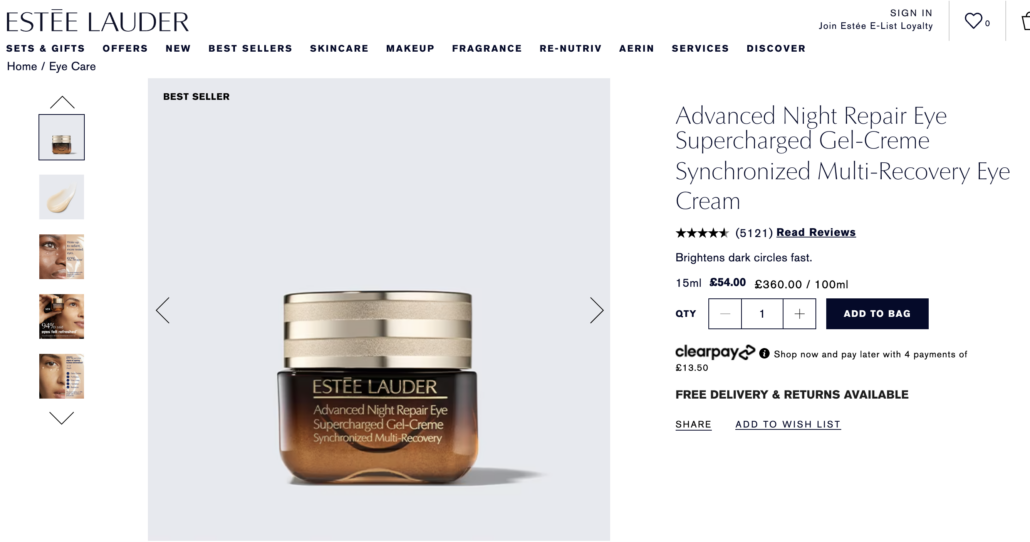
The next step is to incorporate these keywords naturally into your product descriptions, titles, and metadata.
Tip: The Google Search Console can also be used to find keyword opportunities by checking keywords that have higher impressions and fewer clicks. Learn more about this in our article: How to find SEO quick-wins in Google Search Console with low CTR% keywords.
2. Match keyword research to product names
After the keyword research is complete, match your product names with your targeted search queries. Consider including elements such as:
- Brand name (if it is a retailer website)
- Product name (long-tail keyword)
- Relevant product attributes such as colour or size.

3. Write metadata that catches people’s attention
A well optimised title tag and an engaging meta description are important for driving organic traffic to your product pages. It’s an opportunity to capture search users’ attention and encourage them to click on the links and explore your beauty products.
It is important that the metadata be engaging and informative, and that it includes the main keyword and any related keywords. For example, when searching for ‘advanced night repair eye‘ (a term searched 170 times per month in the UK), the first result currently displayed is from the Estée Lauder UK product range. In the title tag, the main keyword is included, while in the description, other relevant keywords are mentioned, such as ‘gel-cream eye.’
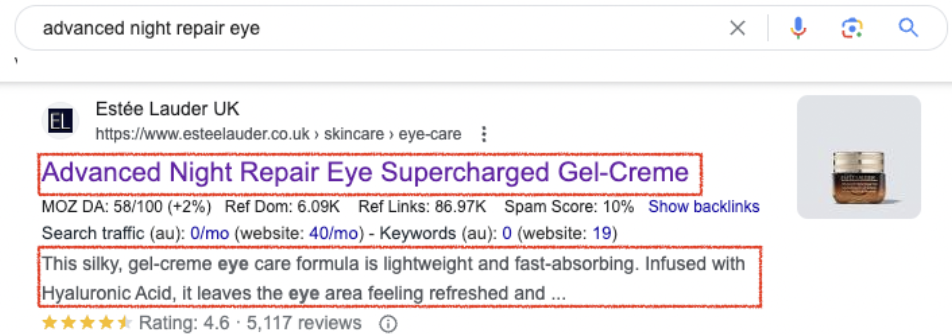
4. Create engaging and informative product descriptions
Make your product descriptions as informative as possible. Having too little information about your product can lead a user to leave. On the other hand, a well optimised product description not only informs potential clients of all the details about your product but also sends more signals to search engines about what your product is.
Provide a detailed description of your beauty products, highlighting their features, benefits, and special characteristics. Try to avoid duplicate content from suppliers and make sure your descriptions are original. Use your chosen keywords naturally throughout the text and utilise bullet points and subheadings to make it easier to read.
5. Include user reviews and ratings for credibility
Allow your customers to leave reviews and ratings on your product pages. This will benefit your business in the competitive online beauty industry.
Adding user-generated content to your website will help to build trust with potential buyers, and fill your website with engaging and keyword-rich content. Whether these reviews are positive or negative, it’s important to engage with them actively.
Your brand’s reputation and credibility will significantly improve by demonstrating your commitment to customer feedback and interaction.
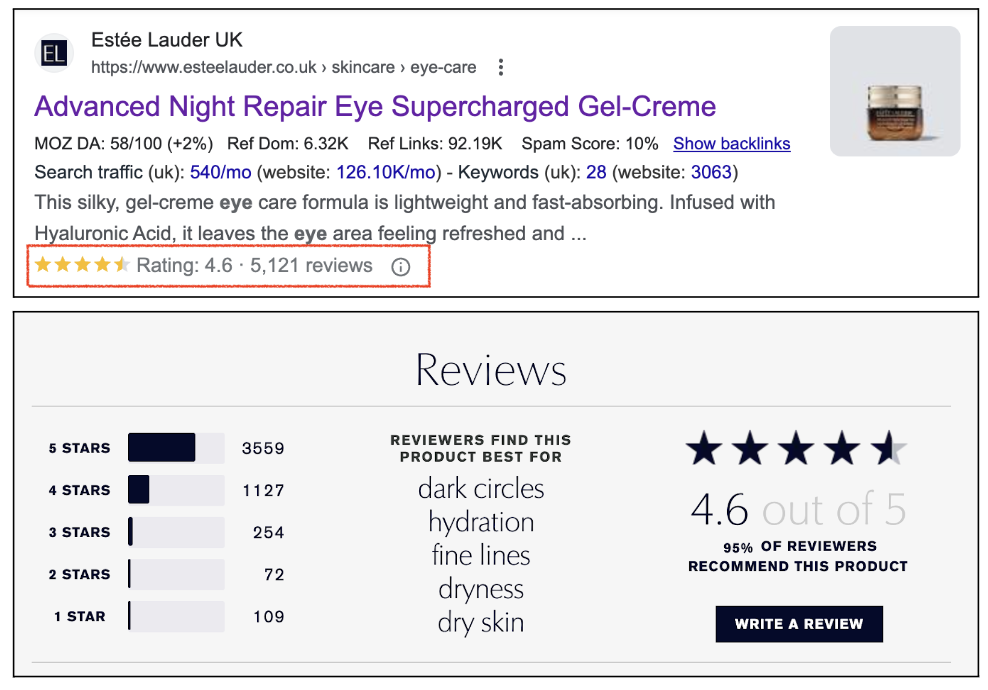
6. Regularly update content
Be sure to update your product listings regularly to reflect your current inventory and to remove any outdated products. You may also want to include a blog or news section on your website, so you can share articles and updates related to the beauty industry and then link to those articles from product pages. The purpose of fresh content is not only to keep your audience engaged but also to inform search engines that your website remains active and relevant.
7. Write clear and helpful FAQs
Incorporating FAQs into your product pages is crucial because they offer valuable insights about your products, enhancing the user experience, driving more conversions, and building trust. Providing answers to common queries and concerns directly on the product page will simplify the decision-making process for potential customers, which in turn reduces bounce rates. Additionally, for SEO reasons, it’s a good opportunity to include relevant keywords within these FAQs, be it in the questions or the answers. There are different ways to discover question opportunities, including by using search engines or tools such as SEMrush, Ahrefs, and People Also Ask.
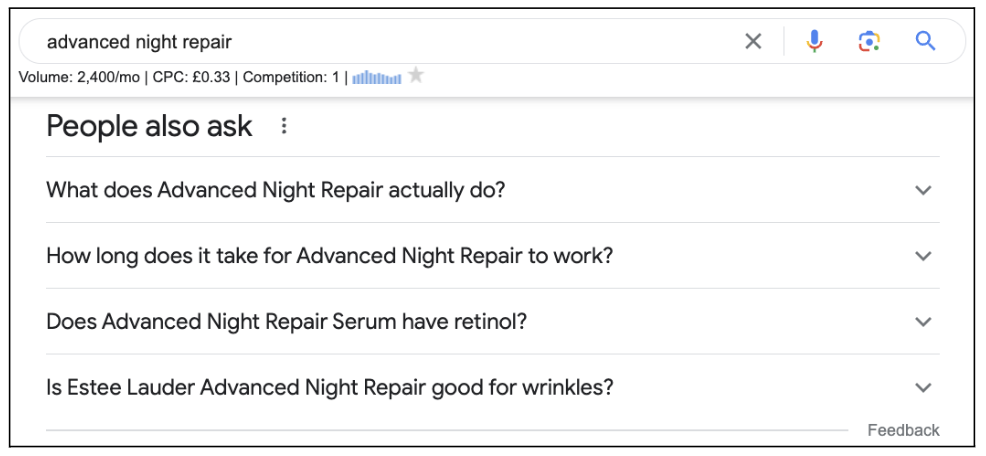
8. Add a ‘You might also like’ feature
Consider adding “You might also like” product suggestions to your product pages. Offering alternative options will keep visitors engaged, especially those who are unsure about their purchase. In this way, you may encourage them to explore new products and perhaps consider purchasing more items in the future.
This strategy is also a good opportunity to improve the internal linking of your website and improve the authority of your product pages.
9. Consider SEO seasonality for a well-rounded strategy
The demand for different products fluctuates throughout the year due to a variety of factors, including holidays, weather, and cultural events. Adapting your SEO strategy and product page content according to these seasonal patterns can ensure that your website is properly positioned to attract and convert customers during peak seasons. Taking this approach will not only improve online visibility and organic traffic but will also improve the user experience, which will lead to more sales and revenue.
There are a few powerful resources that you can use to identify seasonal trends in your industry, including tools such as Google Trends or SEO monitor trends.
Tip: If you want to learn how to create a seasonal dashboard based on your current categories, this article explains more: How to Capitalise on Seasonal Customer Behaviour.
Technical SEO For Beauty Product Pages
10. Make use of engaging visuals
In the beauty industry, visual elements play a key role. Displaying top notch imagery and videos can have a significant impact on your product pages by capturing users’ attention immediately. Engaging visuals improves the user experience, making it easier for customers to compare and connect with products personally.
Additionally, consider enriching the user experience by including videos that illustrate product features and benefits.
11. Add high-quality, optimised images with descriptive alt text
The speed of a website is one of the factors used by search engines to decide on rankings, so the speed of image loading is also important. Optimising your images for fast loading will reduce bounce rates and keep users on the page. To make sure your images load fast, make sure to:
- Choose the right image format
- Display the right image size
- Compress your images
Make sure you include descriptive alt text to help search engines understand your content. The descriptive alt text provides context, allowing search engines to index the images accurately and improving rankings.
12. Mobile optimisation
According to a 2018 Facebook study, 41% of make-up shoppers have bought products online, and 27% have purchased using a mobile device. So, mobile friendly product pages are crucial. There are several reasons for this:
- It directly impacts user experience, as mobile optimisation ensures that customers can easily access and navigate your website on smaller screens, leading to increased engagement and potentially higher conversion rates.
- Google places significant emphasis on mobile optimisation when ranking websites, which means that websites that are not adapted to mobile users can get lower search visibility and organic traffic.
13. Implement internal linking for improved navigation
Use internal links strategically to guide users to related products and pages on your website. This not only improves user experience but also spreads authority throughout your site. When linking, use descriptive anchor text that includes relevant keywords to help search engines understand the content and context of the linked pages.
You can strategically incorporate internal links within product pages in various ways. Here are some appropriate areas to include them:
- Product descriptions: Link to pages with detailed information about specific product features, specifications, or instructions.
- Related products: Provide links to similar or complementary products, encouraging users to explore other options.
- Collection pages: Link to the broader category or collection in which the product belongs. This helps users navigate to a wider range of products within the same category. Use breadcrumbs to do this.
- Customer reviews: Link to customer reviews, testimonials, or case studies that provide more information or showcase the product’s benefits.
- Blog posts or articles: If you have articles related to the product or its uses, link to these resources to provide users with more information and context.
- FAQs or Support Pages: Link to FAQs or support pages that address common questions or issues related to the product
Learn more in our article: A Strategic Approach to Internal Linking for SEO.
14. Apply Schema Markup to enhance search result
By incorporating schema markup into your beauty product listings, you can help them stand out in the search engine results. Schema markup enriches search results by offering extra details about your products, such as pricing, availability and reviews directly on the search results page.
Make sure you optimise the merchant listings displayed on the Google Search Console feature to boost your sales through Google Shopping’s free product listings:
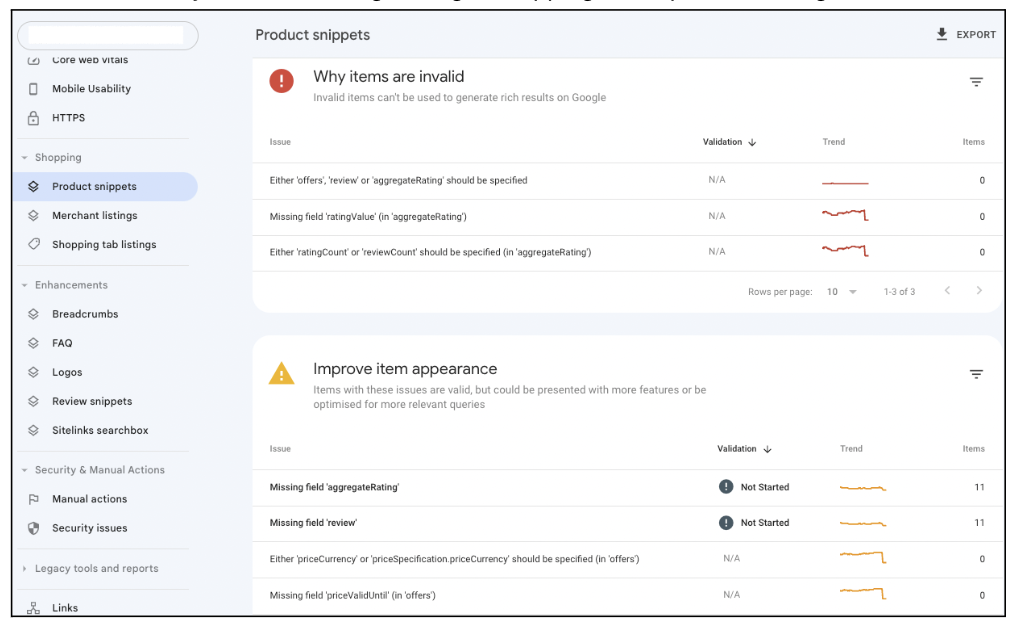
The feature can improve click-through rates and make product pages more attractive.
15. Use breadcrumb navigation for a user-friendly experience
Implementing breadcrumb navigation contributes to smoother and more user-friendly website usability. Breadcrumbs provide users with a clear and structured path to navigate through a website, helping them understand their current location within the site’s hierarchy.
By using this feature, users can also go back and explore related content from their product category more easily, reducing confusion and frustration.
From an SEO perspective, breadcrumbs provide valuable information about a site’s structure and hierarchy. So it’s important to make sure to mark up your breadcrumbs with Schema to ensure search engines understand and index more accurately.
16. Minimise page load times for a smooth browsing experience.
Search engines consider page speed as a ranking factor, so optimising page load times not only benefits user experience but also plays a key role in SEO, improving a website’s visibility.
When web pages load quickly, it enhances the user experience by reducing frustration. In the context of product pages, this becomes particularly crucial, as users often demand instant access to information, images, and details about the products they are interested in. To learn more about page speed, read our article: How to Optimise Your Website for Core Web Vitals: LCP, FID, and CLS.
17. Prevent product pages from being isolated and becoming orphan pages
Orphan pages exist outside the site’s structural hierarchy when they aren’t linked to anywhere on your site, such as sitemap, menu navigation, footer, text links or from the categories etc.
Keeping track of large product inventories can be challenging. Whenever a category is removed from the website, product-related pages can become orphan pages if they aren’t linked to other categories or anywhere else. This means that if this happens, we have to ensure that the products link to other categories or locations, otherwise they won’t be found. In more severe instances, Google may even remove these products from indexing altogether. It’s important to remain vigilant in such situations and address them promptly.
More than cosmetic changes to your website
In conclusion, effective product page SEO is essential for the success of your beauty industry business online. If you follow these best practices, in both content and technical areas, you will improve your SEO rankings and drive more organic traffic to your product pages.
Also, it’s crucial to stay on top of SEO trends and algorithms to maintain your competitive edge in the beauty industry. Sign up for our newsletter to get E-commerce marketing and SEO tips sent to your email every two weeks for free.
Our team has plenty of experience working with beauty industry brands and is ready to help you optimise your website. Contact us today for help and advice for improving SEO on your beauty industry eCommerce website.

